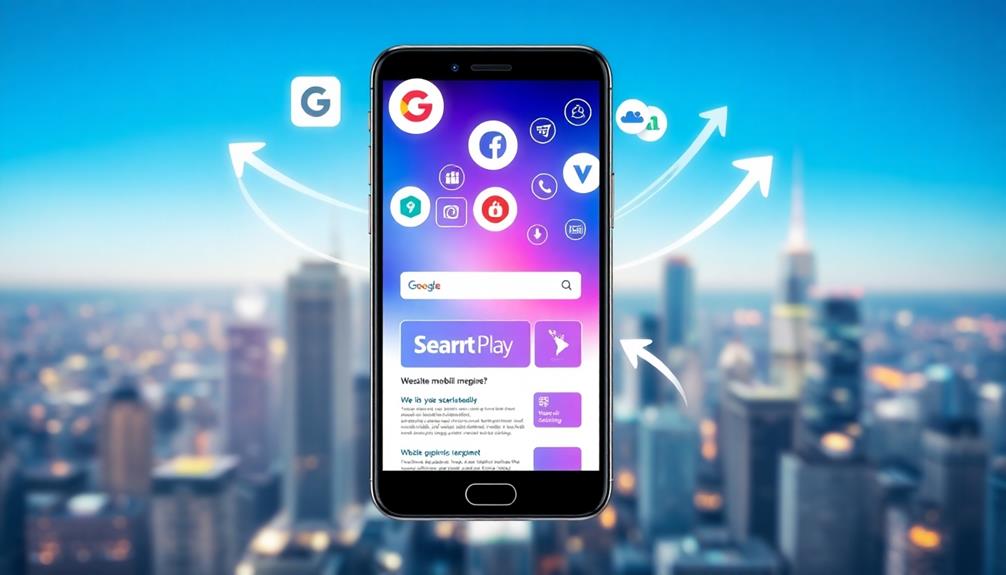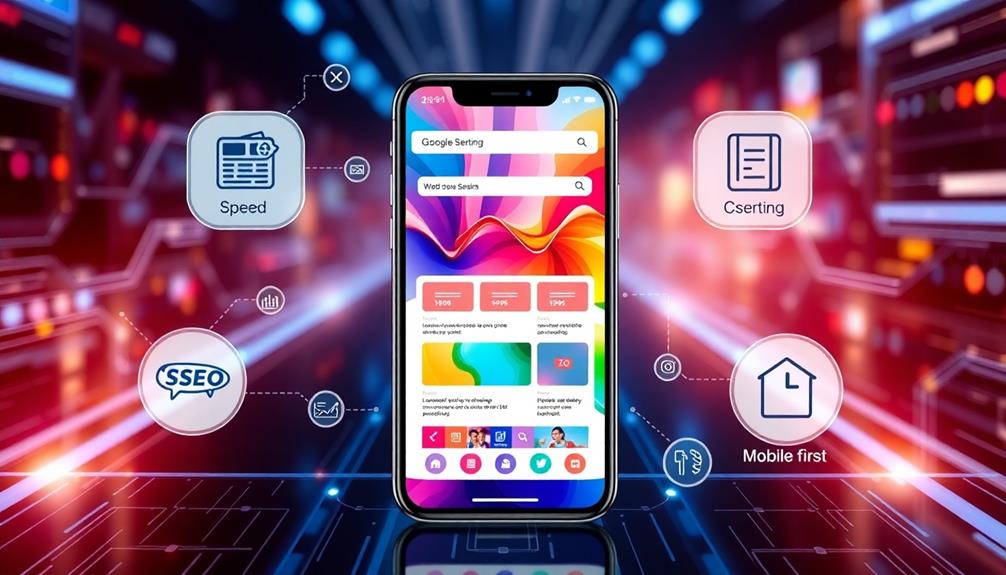Mobile optimization in 2025 is vital for your online success. With over half of global web traffic coming from mobile devices, you can't afford to ignore it. Google prioritizes mobile-friendly sites in search rankings, so a responsive design is essential. Poor optimization leads to high bounce rates and lost conversions. Fast loading times also enhance user experience, making users more likely to stay and engage. As trends like voice search and 5G technology shape the future, adapting to these changes will keep you competitive. Discover how to refine your mobile strategy for maximum impact moving forward.
Key Takeaways
- Mobile optimization will remain crucial as over 50% of global web traffic continues to come from mobile devices in 2025.
- With the advent of 5G, faster loading times and seamless experiences will heighten user expectations for mobile sites.
- Voice search integration will be essential, as more users rely on voice commands for search queries and navigation.
- Websites must adopt responsive design to ensure compatibility across various devices and screen sizes for an optimal user experience.
- Regular performance testing will be vital to maintaining high conversion rates and minimizing bounce rates as mobile usage evolves.
Mobile-First Indexing Explained

As we move further into 2025, understanding mobile-first indexing becomes vital for your online presence. Mobile-first indexing means that Google primarily uses the mobile version of your website for ranking and indexing. With over 50% of global web traffic coming from mobile devices, prioritizing mobile optimization is essential for maintaining your visibility in search results.
Topical authority's role in SEO rankings highlights the importance of a strong mobile presence.
Websites that feature separate mobile and desktop versions often face ranking inconsistencies. Google favors responsive design, which guarantees a seamless user experience across all devices. If your website design isn't mobile-friendly, you're risking poor mobile optimization, which can lead to significant drops in both search rankings and visitor numbers.
Adapting to mobile-first indexing isn't just a trend; it's a necessity for engaging effectively with mobile users. A strong mobile presence allows you to connect with your audience where they're most active. Ignoring mobile optimization could hinder your ability to compete in the digital landscape.
To thrive in 2025, make certain your website is designed for mobile-first indexing, enhancing user experience and ultimately boosting your search rankings.
Assessing Mobile Optimization Readiness

To guarantee your website is ready for mobile optimization, you'll want to conduct a thorough assessment of its performance on mobile devices. Start by utilizing Google's Mobile-Friendly Test to quickly determine if your site meets mobile optimization standards. This is essential for maintaining visibility in search results.
As AI tools enhance user interaction, consider how they can be leveraged to improve mobile user experiences. Use Google Search Console to monitor key metrics like mobile usability and page load speed, both critical for SEO success.
Regular checks and continuous monitoring of mobile performance are fundamental. Even slight changes in mobile optimization trends can greatly impact your SEO rankings and user engagement. Pay attention to key performance indicators (KPIs) such as mobile conversion rates and bounce rates. These metrics provide valuable insights into the effectiveness of your mobile strategy.
Don't overlook the importance of implementing structured data. This can enhance your mobile site's indexing efficiency, making it easier for search engines to understand and rank your content properly.
Key Mobile SEO Strategies

Ensuring your website is ready for mobile optimization sets the stage for implementing effective mobile SEO strategies that drive results.
Start with responsive design; it adjusts your website layout to various screen sizes, enhancing user experience and boosting your higher rankings in search results. Additionally, addressing technical SEO errors such as broken links and slow loading times is vital as they can negatively impact user engagement and search rankings.
Page load speed is significant, too—slow-loading pages can lead to a significant bounce rate, so use techniques like image compression and browser caching to improve speed.
Next, focus on mobile-friendly content. Users prefer readable content with shorter paragraphs and bullet points, making it easier for them to consume without zooming.
With the rise of voice search optimization, adapt your content to include long-tail keywords and natural language, as more households will rely on smart speakers by 2025.
Implement structured data to enhance your visibility in mobile search results. This helps create rich snippets that display essential information like ratings and prices, potentially improving your click-through rates by up to 30%.
Enhancing User Experience

To truly enhance user experience on mobile, you need to focus on intuitive navigation design, streamlined content presentation, and touch-friendly interactions.
Implementing strategies like the art of decluttering your content can further improve clarity and engagement.
When your site is easy to navigate and presents information clearly, users are more likely to stay engaged.
Intuitive Navigation Design
An effective mobile website's intuitive navigation design is essential for enhancing user experience. With 88% of users less likely to return after a bad experience, prioritizing seamless interactions on mobile devices becomes critical. You want to create an environment where users can effortlessly find what they need, just like how the best vacuums for hardwood floors facilitate easy cleaning with their intuitive designs.
Focusing on touch-friendly elements is key, as 70% of users prefer tapping over scrolling on smaller screens. This enhances engagement and keeps users on your site longer. A simplified menu structure can considerably boost user retention—up to 50%—by enabling users to locate desired content quickly, reducing frustration.
Moreover, remember that mobile users spend 80% of their time in apps, so ensuring easy-to-navigate interfaces is essential for satisfaction. Incorporating clear call-to-action buttons and minimizing cognitive load will further enhance the navigation experience.
Research shows that intuitive navigation can improve conversion rates by up to 200%, as users are more likely to complete desired actions when they can navigate with ease.
Ultimately, investing in intuitive navigation design not only enhances user experience but also fosters loyalty and drives success in your mobile optimization efforts.
Streamlined Content Presentation
Streamlined content presentation is crucial for capturing attention in today's fast-paced mobile environment. With over 50% of global web traffic coming from mobile users, you need to make sure your content is easily digestible.
Research shows that 79% of mobile users prefer scanning content rather than reading every word. This highlights the need for concise text and well-structured layouts. Implementing strategies such as AI-driven content optimization can greatly enhance your content's relevance and authority, making it even more appealing to your audience.
Implementing responsive design allows your content to adapt seamlessly to various screen sizes, enhancing user experience across devices.
To further improve engagement, optimize images and fonts for fast load times; even a 1-second delay can result in a 7% drop in conversions. Clear navigation is crucial, as it reduces bounce rates and keeps users engaged with your content.
Touch-Friendly Interactions
Mobile users' preferences for touch-friendly interactions can't be overstated; 88% of them favor using their fingers for navigation. When you're designing mobile sites, incorporating touch-friendly interactions is essential for enhancing user experience.
With screens typically ranging from 4 to 7 inches, it's vital to implement intuitive design elements like larger buttons and spaced-out features. This not only prevents accidental clicks but also increases user satisfaction. Additionally, leveraging AI technologies can help tailor mobile experiences by analyzing user behavior and preferences, further refining the design process.
Did you know that approximately 70% of mobile users abandon a site that's not optimized for touch? This statistic highlights the importance of user-friendly interfaces in retaining visitors. By focusing on touch-friendly navigation, you can see a significant boost in conversion rates—up to 20-30%!
Incorporating design elements such as swipe gestures and touch-responsive animations can further improve engagement, making your mobile sites feel dynamic and responsive.
Measuring Mobile Strategy Effectiveness

How can you accurately gauge the effectiveness of your mobile strategy in 2025? Start by focusing on key performance indicators (KPIs) like mobile conversion rates, page load times, and user engagement metrics. Analyzing mobile-specific bounce rates is essential, as studies show that even a 1-second delay in load time can lead to a 7% reduction in conversions.
Customer feedback provides invaluable insights into usability and features that resonate with users, helping you refine your approach. By regularly monitoring mobile traffic patterns, you can adapt your strategies based on shifting user behavior and preferences. Utilizing tools like Google Analytics to track these metrics allows you to make data-driven decisions, enhancing your mobile strategy effectiveness.
Here's a quick reference table to help you visualize these metrics:
| Metric | Purpose |
|---|---|
| Mobile Conversion Rates | Measure sales or goal completions |
| Page Load Times | Assess user experience and engagement |
| User Engagement Metrics | Track interactions and content consumption |
| Mobile-Specific Bounce Rates | Identify areas needing improvement |
| Customer Feedback | Gather insights for future enhancements |
Tools for Mobile Performance Testing

In 2025, a variety of tools are available to guarantee your mobile performance meets user expectations and business goals. Google PageSpeed Insights is a must-have for analyzing your web page's content. It offers suggestions to improve mobile performance, allowing you to enhance load times and boost your SEO rankings effectively.
Regular maintenance of your site can be likened to optimal usage timing and conditions for air purifiers, as both require ongoing attention to function at their best.
You should also consider tools like GTmetrix, which measure load times and provide detailed insights into optimization opportunities tailored specifically for mobile devices. Lighthouse stands out as a powerful resource, evaluating mobile performance, accessibility, and SEO best practices while generating actionable reports for developers like you.
Regular checks with these mobile performance testing tools are essential. Remember, 53% of mobile users abandon sites that take longer than three seconds to load. This statistic highlights the pressing need for continuous optimization.
Future Trends in Mobile Optimization

As 5G technology rolls out in 2025, you'll notice a dramatic boost in mobile browsing speeds, enabling richer content that enhances your user experience.
To keep up, you'll need to rethink your approach to voice search integration, as more users will turn to conversational queries for information.
Additionally, ensuring features like keeping Ring Doorbell charged will be vital for maintaining effective connectivity in smart devices.
Embracing these trends will be essential for staying relevant and engaging your audience effectively.
5G Connectivity Impact
With the rollout of 5G connectivity transforming the mobile landscape, you're set to experience mobile browsing like never before. This leap in technology isn't just about faster loading times; it's about an entirely enhanced user experience. As mobile networks handle more devices, you'll notice smoother interactions and less downtime.
Furthermore, businesses can leverage energy efficiency ratings to optimize their mobile platforms, ensuring faster and more reliable service for users.
Imagine:
- Seamless streaming of your favorite shows without buffering.
- Immersive user experiences through augmented and virtual reality apps.
- Higher user engagement as businesses adapt to your needs with Progressive Web Apps optimized for mobile.
5G connectivity allows advanced technologies to flourish, facilitating content delivery that captures attention instantly. You'll find that websites and applications are now designed to harness this power, ensuring that everything you access isn't only quick but also visually engaging.
As businesses pivot to meet these new demands, you'll benefit from enhanced experiences that keep you coming back for more. In this new era, mobile optimization becomes essential for brands aiming to stand out in a competitive landscape, making your mobile interactions more enjoyable than ever before.
Voice Search Integration
Voice search is rapidly becoming a game-changer in mobile optimization, transforming how users interact with their devices. By 2025, voice search is expected to account for 50% of all online searches, making it vital for you to optimize your content for conversational phrases and natural language.
As 72% of smart speaker users integrate these devices into their daily routines, it's clear that prioritizing voice search can enhance user engagement and accessibility.
To effectively optimize for voice search, focus on long-tail keywords, as 70% of voice queries consist of three or more words. This shift in your keyword strategy can greatly improve your visibility.
Implementing structured data is also essential; it helps search engines understand your content's context and relevance, leading to better rankings and user experience.
As mobile devices dominate internet access, businesses that embrace voice search optimization are likely to see improved conversion rates. In fact, 55% of consumers use voice search for product research.
Content Optimization for Mobile Users

Capturing attention in a mobile-first world demands that your content is both concise and engaging. To achieve this, focus on optimizing your mobile content to enhance user experience.
Studies show that concise content can increase user engagement by 62%. You can make it easier for users to scan by using shorter paragraphs and bullet points, which improve readability on smaller screens.
Here are some key strategies to implement:
- Optimize images to reduce loading times by up to 70%, ensuring faster access to your content.
- Use mobile-friendly keywords and meta descriptions tailored for mobile searches to boost click-through rates by 20% or more.
- Implement structured data to enhance content visibility, leading to a potential 30% increase in organic traffic via improved rich snippets.
Importance of User Engagement

User engagement is essential for the success of any mobile strategy, as it directly influences retention and conversion rates. When you prioritize mobile optimization, you create a seamless user experience that encourages mobile users to interact with your brand. Faster loading times and better usability can increase user engagement by up to 50%. Remember, 61% of users won't return to a mobile site after a poor experience, making it vital to keep them satisfied.
Offering personalized user experiences helps too. A staggering 70% of consumers prefer tailored content on their mobile devices, enhancing their engagement. Implementing interactive mobile features, like click-to-call and location-based services, can further boost engagement by 25%.
Here's a quick look at how these factors play into user engagement:
| Factor | Impact on User Engagement |
|---|---|
| Loading Times | Affects retention rates |
| Personalized Experiences | Increases user satisfaction |
| Interactive Features | Encourages more interactions |
Frequently Asked Questions
What Is Mobile Optimization and Why Is It Important?
Mobile optimization's about ensuring your website looks and works great on mobile devices. It's important because it improves user experience, boosts engagement, and helps you rank higher in search results, leading to more conversions.
Why Is It Important to Optimize Website and Content for Mobile Users?
Optimizing your website and content for mobile users is essential because it improves user experience, boosts engagement, and increases conversion rates. You'll reach a larger audience, enhance your brand's reputation, and keep users coming back.
What Is Mobile SEO?
Mobile SEO is optimizing your website for mobile devices, ensuring it's user-friendly, loads quickly, and ranks well in search engines. You need responsive design, fast speeds, and mobile-friendly content to retain visitors effectively.
How to Optimise Your Website for Mobile?
Your website's not just a page; it's a rocket ship waiting to soar! Optimize it for mobile by ensuring responsive design, speeding up load times, using scannable content, and regularly testing for usability.
Conclusion
In 2025, mobile optimization isn't just a nice-to-have; it's crucial for your online success. Think about it: if your site isn't optimized for mobile, you're fundamentally closing the door on a huge portion of potential visitors. By prioritizing mobile strategies, enhancing user experience, and engaging your audience, you'll not only meet their needs but also stay ahead of the competition. So, are you ready to embrace the mobile-first future and access your site's full potential?










